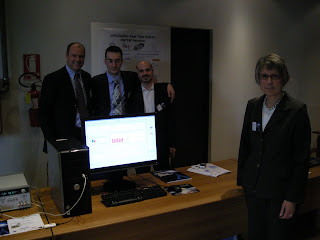Today we want to start using this site as an actual Blog, posting our feelings, comments and news from the ENC-GNSS conference and the Toulouse Space Show.

The NavSas team attending the conference is kind of relevant: Letizia Lo Presti, Riccardo Lesca, Davide Margaria, Ta Tung and myself from Politecnico, Massimiliano Spelat from TorinoWireless, and Luigi Bragagnini from the Consortium Torino Time. There are also several NavSAS friends as Gianluca Boiero from Telecom Italia, Francesco Longo from ASI, Marracci from Intecs and others.
Today some of us attended the GNSS Signal Workshop, where several interesting presentations suggested several ideas for future research works.
Tung attended a couple of interesting tutorials.
Then all together we attended the opening session, with a nice speech from Vidal Ashkenazy, brilliant, funny and smart as usual.
The official opening included several welcome speeches by local politicians and by the ministry of research and higher education. The presence of press and TV has been really impressive due to the importance given to the event; France is really determined to maintain a prominent role in Space development, and keeps investing in its outstanding Toulouse space district.

The funny part of the opening has been the breaks between the speeches, thanks to 2 singers, performing songs on space subjects (watch the video).
Now it’s time for the welcome cocktail , some dinner and then time to finalize the presentations for tomorrow when the technical sessions will start.
News and rumors from the ENC:
- we officially know now that the next year the ENC will be at the Pathenope University in Naples from the 3rd to the 6th of May 2009. Many people met at the conference and, I have to say, myself too have some concerns about the place (not a conference center) and dates (3rd May is a Sunday !) . We will see what is going to be presented during the last day, even if the presentation by the Italian Institute of Navigation is reported in the program as TBC.








































